Intro
Most progressive companies tend to use the DevOps model to organize their day-to-day processes of production and development in the most efficient way. As representative examples of DevOps successful utilization in business, we can count in such famous organizations as Google, Amazon, Target, Netflix, Walmart, and many others. Notably, DevOps practices help these companies to establish continuous development and delivery processes, automate routine tasks and maintain the quality of products and services. Basically, all software engineering companies choose to adopt DevOps in IT service delivery because it’s been proven that the DevOps process of software development enables the creation of high-quality solutions. Let’s find out more about the DevOps concept for a better understanding of what place it takes in business improvements. We’ll define DevOps and its processes, describe DevOps workflows, and explain why DevOps is important.
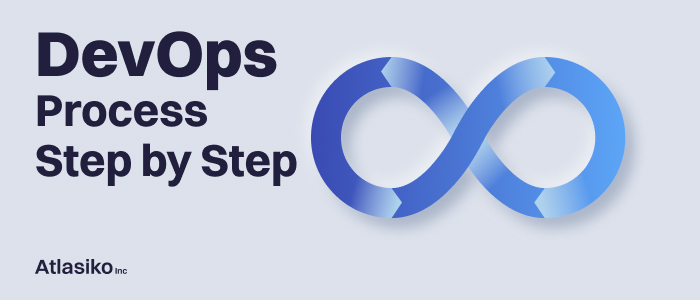
What is the DevOps process?
To begin with, it’s important to define DevOps meaning in software development and in general. Understanding DevOps will help you to discover ways how to improve business and facilitate development and management processes. Atlasiko Inc. offers you our high-quality DevOps consulting to develop DevOps process from scratch for your projects. Our software engineering firm also uses DevOps workflow for our solutions so our clients are always sure that we provide them with top-notch IT products.
What does DevOps mean?
Firstly, let’s outline what DevOps for IT is. Diving into the topic, it’s clear that DevOps is an abbreviation, so the first question that usually appears is “What does DevOps stand for?”. In our previous article, we defined that this term combines two words, and the complete form of DevOps stands for development and operations. Let’s review the definition.
Such a concept as DevOps means a set of methods, practices, and philosophic approaches to the software development process when development and operations teams work in close collaboration and aspire to deliver a responsive, market-ready solution.
The key purpose of DevOps is to reach agility in software development. It means that all processes and stages of the creation and deployment are easily adaptable to changes thanks to thorough communication and collaboration between the development and operations departments.
Definition of DevOps processes
The meaning of DevOps processes is pretty much connected to the DevOps description itself. When we talk about the DevOps process we refer to the cycle of established DevOps phases that enables efficient software development. The combination of DevOps methodologies, practices, and tools organized in the DevOps loop is what creates the agile intake process.
How does DevOps methodology work in practice? A simple example
Let’s put all these terms in simple words with some DevOps examples. Basically, in practice, all processes of the DevOps lifecycle are divided between two DevOps teams. Developers are responsible for the DevOps phases of planning, coding, building, and testing, while the Ops team takes care of the release, deployment, operation, and monitoring stages. One of the leading DevOps goals is to create a thorough connection between these two departments. Without this collaboration, the development process might become taxing and overpriced.
So to make a quick overview of DevOps let’s say that the Dev team works on an AR solution for a furniture store. They create feature-rich software, test it with testing tools and do all required functional checking in their production environment. The operations team releases this AR solution and delivers it to the store, which requested AR development, and clients start using it. Everything seems perfect, but users start reporting that some features don’t work in real-world environments, Of course, the Ops team has some complaints to the developers because of the poor quality of their solution. The Dev crew defends their work because the AR application performed perfectly while testing, so it must be the Ops team's mistake while transferring the solution to the real world. The situation could’ve been avoided if the Operations crew took part in the DevOps development process supplying programmers with insights on the market and real-world environments, and developers, in their turn, promptly reacted to such improvement suggestions by changing codes and features. The DevOps approach supposes that such cooperation starts from the very concept creation stage to ensure success with the project fulfillment.
Atlasiko Inc. follows all principles of DevOps creating IT products so our AR solutions are always optimal and responsive. Check out our Augmented Reality Services that will help your business to gain competitive advantages. You can find out more about the DevOps process.
What are DevOps principles?
As DevOps isn’t just tech components but also a mindset that an organization adopts in the way it manages business processes, DevOps principles match those of Agile methodology. However, the main focus and principle of DevOps is automation with the support of DevOps lifecycle tools.
- DevOps automation
This is the DevOps basic principle. It implies that all DevOps stages are automated in order to form an uninterrupted development process with less possible amount of manual work and employee involvement. DevOps and automation of its procedures via a special set of tools encompass DevOps flow i.e. DevOps planning, software build processes, code testing, developer operations, maintenance, etc. DevOps concepts of automation allow companies to shorten their expenses and prevent overwork hours for employees. - Iteration
Agile DevOps methodology supposes the use of timeboxes as units of time where DevOps activities are carried out. According to the iteration principle of DevOps, the developers repeat the testing procedure of such units every time after writing small blocks of code to ensure software responsiveness and security. - Constant improvement
Continuous testing and analysis of feedback allow software engineers to fix issues, improve functionality and usability, and optimize the time of solution deployment. This way, you can achieve the outstanding quality of IT products that will be in demand among clients in the global market. - Collaboration and communication
It’s safe to say that implementing DevOps is impossible without setting up a thorough collaboration between development and operations departments and coordination of their interactions. The DevOps approach will bring businesses successful results only if the operations team supplies the development team with suggestions and reports on market requirements and product exploitation issues, and the developers, in their turn, make improvements based on this info.
DevOps process flow
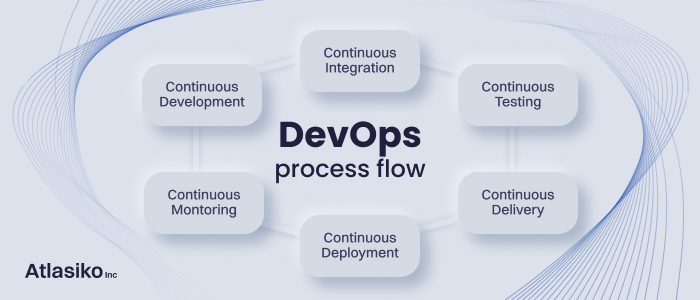
DevOps process contains many useful DevOps practices that were developed through years of implementing DevOps concepts in the software production business. All these developer operations are aimed to ensure automation, heighten productivity, and provide quick ways of resolving issues and fixing bugs in the software build processes.
Continuous Integration
According to this DevOps practice, the developer makes numerous daily modifications to the shared repository's source code. When even little modifications are made to a bigger codebase, they get to be tested and reported. Continuous integration (CI) aims to provide quick feedback so that any flaws can be found and fixed right away.
Continuous Testing
To get quick input on the business risk connected to software release, continuous testing is required as one of the DevOps practices. It is a difficult and crucial component of the software. Testing is a necessity for software rating. Automated testing tools are utilized because it is simpler to test continually rather than testing a whole piece of software. The developer uses the test function to balance quality and speed.
Continuous Delivery
Continuous delivery (CD) is the capability to make adjustments, such as adding new characteristics and features, managing configurations, fixing bugs, and putting experiments into production. A continual daily upgrade is our driving force behind continuous supply. If there is a mistake in the production code at that point, we can easily repair it. So, here we are quickly, consistently, and with the least amount of overhead creating and releasing our application.
Continuous Deployment
As soon as the code successfully completes all test cases, it is promptly deployed to the manufacturing environment for production. Alternate versions of the code are always present in the right places thanks to continuous updating. Continuous deployment many consider a better variant for IT DevOps production than CD because it doesn’t require manual work from employees. Every update to the code is automatically deployed with the help of DevOps deployment tools, leading to several deployments in the production environment every day.
Continuous Monitoring
DevOps lifecycle tools include a reporting tool that enables developers and testers to assess the functionality and performance of their applications before it is implemented in operations. To reduce the number of errors and changes, continuous monitoring provides feedback.
Continuous Development
The iterative process for creating software that will be provided to users is called "continuous development". Continuous integration, testing, delivery, and deployment are all components of it. So we can say that continuous development is a sort of umbrella term for other DevOps basics. Organizations can provide innovative features or goods more quickly, with lower risk and improved quality, by utilizing a continuous development strategy and its related sub-strategies, without encountering substantial bandwidth constraints.
Breakdown of DevOps lifecycle

- Planning
At this DevOps process stage the project planning process takes place. Stakeholders along with developers decide on desired features of future software, quality criteria for each development phase, and CI/CD process flow value. It’s wise to involve other departments like the marketing crew, system administrators, tech writers, etc. in the process of plan creation. Collaboration among all participant teams of DevOps planning is the key to ensuring successful project execution. - Coding
After all features, that software should have, are determined in the planning phase, programmers can start the coding process. At this stage, it’s important that developers follow one of the main DevOps principles of iteration and use suitable DevOps lifecycle tools for CI to check their code chunks in a centralized repository. - Building
As a part of the DevOps development process, in this phase developers retrieve checked code from the repository via a special tool with automation of this process. The tool automatically transfers code lines in a binary artifact, tests the functionality, and publishes the results in the centralized repository. - Testing
Software development cannot be done without testing as one of the DevOps lifecycle phases. All components and parts of software have to be checked carefully in accordance with the DevOps practice of continuous testing. To facilitate this process, developers use automated tools for testing. Stakeholders also use testing reports to find out about the development process and get valuable insights. - Release
DevOps steps include the release phase as the first one in the responsibility of the operations team. Here, they take care of change management, get all needed release approvals from stakeholders, and organize automated releases. - Deployment
Continuous deployment pipeline enables collaboration between developers and operations crew in integrating all code changes without manual work. Deployment tools in DevOps processes help to include these changes in production directly which influences the productivity and velocity of the software delivery process. - Operation
Operations stage of the DevOps agile process supposes management of software production and DevOps production support by IT admins. It includes installation, configuration, and changes of infrastructure, database and resource management, and security testing. All these procedures are carried out with infrastructure-as-code tools. - Monitoring
This DevOps support model component represents the DevOps approach of continuous monitoring. In this process, both development and operations teams are involved to make certain that the product of their work functions properly and to be able to fix any issues promptly with a maximum level of automation.
We elaborated on the description of the DevOps process flow components and DevOps lifecycle in one of the following articles. Read our extensive analysis of the DevOps lifecycle.
Benefits DevOps methodology and processes bring to the way companies work
Shorter time to market
The reason why DevOps methodology was created and the main DevOps goal is to accelerate the development and deployment process, facilitate and quicken innovation of production. Undoubtedly, software development and its implementation tend to drag out if the connection between developers and the operations crew isn’t established. Whilst thorough collaboration of these departments enables shortening of the production cycle. Therefore, you don’t need to work through the same issues over and over again but can efficiently solve them with insights from the development and operations teams.
Efficient collaboration and communication
The production process built on DevOps principles and practices supposes collaboration among all departments involved in a project. DevOps environment creates all conditions and prerequisites for establishing fruitful communication that results in successful project execution. At Atlasiko Inc., we deliver high-quality IT services giving extra attention to establishing communication within executive teams and with our clients to ensure the successful implementation of your solutions.
Reliability
The more successful projects your company carries out without delays and issues, the more reliable it’ll be in clients’ eyes. DevOps SDLC (software development lifecycle) helps in avoiding postponements and problems with software functionality. Continuous iteration and delivery DevOps practices allow quick testing and automated changes to confirm that software works properly and is ready to be used by clients. This way users won’t be facing solutions with flaws that increases customer satisfaction and your rates of reliability.
Security
The DevOps development model allows ensuring a decent security level for solutions without trading off the velocity of software development. Programmers set up configuration management, compliance policies and other controls to protect data.
Scalability
Such DevOps features as automation and iterations assist in operating and managing complex infrastructure systems at scale. Infrastructure flows improvements are key for increasing efficiency and reducing the risks of mistakes in complicated infrastructure and development processes.

Even though some development projects might appear challenging, professionals of our team take it upon themselves to create an unparalleled solution. We develop programs keeping in mind business needs and goals of our clients.Talk to Expert
How to implement the DevOps process in your business
It can seem overwhelming to build a DevOps process in your company if you haven't already done so. Keep in mind that over time the DevOps methodology has been developing and there has been a change in both processes and culture.
It’s best to consider deploying DevOps gradually as you work to achieve success. Based on where your company is at the moment, you can select to base your DevOps deployment on an agile strategy.
An order of progressive DevOps implementation might resemble this:
- Adopt an agile development methodology;
- Utilize cloud computing;
- Get your procedures in line with a CI and CD workflow;
- Automate software deployment process flow;
- Organize automated software testing;
- Use a continuous deployment DevOps strategy.
Remember that the transition brought about by DevOps automation affects both the infrastructure and the tools. You run the risk of having gaps in your DevOps process flow if you don't have the right infrastructure and tools to back up your processes. Each step of the development and part of the DevOps pipeline architecture needs to be as automated and agile as feasible to build a real DevOps environment.
Also, take into account how visualizations can assist you in mapping out your DevOps processes and in understanding anything from timetables and process flows to who is working on what. Visuals can make the adoption process much easier by having everybody on the same track from the beginning.
What are DevOps tools?
DevOps tools support the main stages of the DevOps lifecycle. They strengthen collaboration, lessen context switching, implement automation, provide observability, and support the DevOps approach.
Both an all-in-one and an open toolchain are common approaches used in DevOps toolchains. An open toolchain enables customization with many tools, in contrast to an all-in-one toolchain that often gives a complete solution without integrating with other third-party tools.
DevOps tools chart
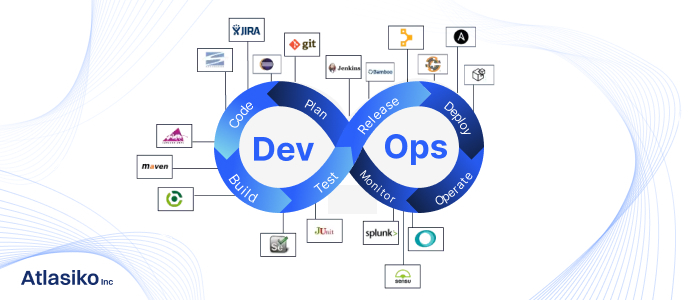
In this DevOps toolchain diagram you can see that different DevOps tools address each individual phase of the DevOps infinity loop. We composed a short list of the most popular software that you can use. Let’s look at some more examples of tools created to automate the DevOps process of program development.
| DevOps lifecycle phases | DevOps lifecycle tools |
|---|---|
| Planning | • GudHub • Slack • Jira Software |
| Coding | • Bitbucket • GitHub • GitLab |
| Building | • Docker• Terraform• Puppet• Ansible |
| Testing | • Jira Software • JUnit |
| Release | • Bitbucket • AWS CodePipeline • Bamboo |
| Deployment | • Puppet • Ansible • Bitbucket |
| Operation | • Appdynamics • Slack • Splunk • New Relic • Dynatrace |
| Monitoring | • JiraServiceManagement • GetFeedback • Slack |
Most of these DevOps software and apps can actually be used for a few phases of DevOps process as they are multitasking. For example, we use our SaaS solution, GudHub, for project management, No-Code building, testing, deployment, and monitoring. The platform also has available functionality for citizen development. Try out the wide-ranging capabilities of GudHub to enhance your DevOps infrastructure.
You can find more excessive info about DevOps tools, their characteristics and use in the following article “30+ Top DevOps Tools”.
Conclusion
We hope that this article gives an answer to the popular question “What are DevOps processes?”. Now you know how DevOps works and that the DevOps process promotes quicker, better application development as well as quicker distribution of new or updated software features or goods to customers.
Atlasiko Inc. utilizes DevOps concepts with high efficiency. Developers in our IT services company make quick and high-quality work in coding and building software and applications with thorough testing while operations teams provide automated infrastructures, organize release and monitoring of software performance and cooperate with development teams for improvements. In both on-premises and cloud environments, you can confidently offer your firm the services and capabilities it requires to optimize application performance with Atlasiko software development services.



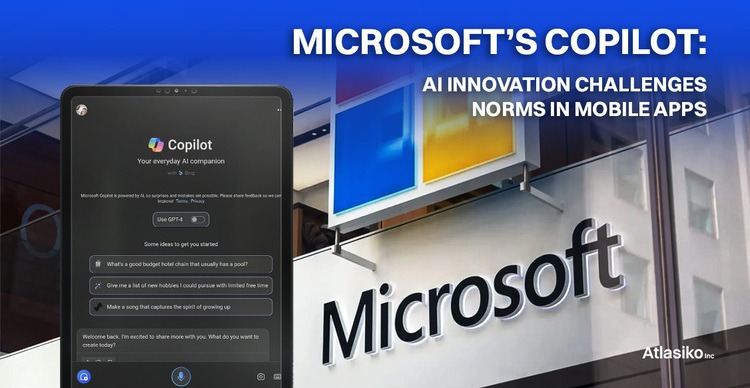

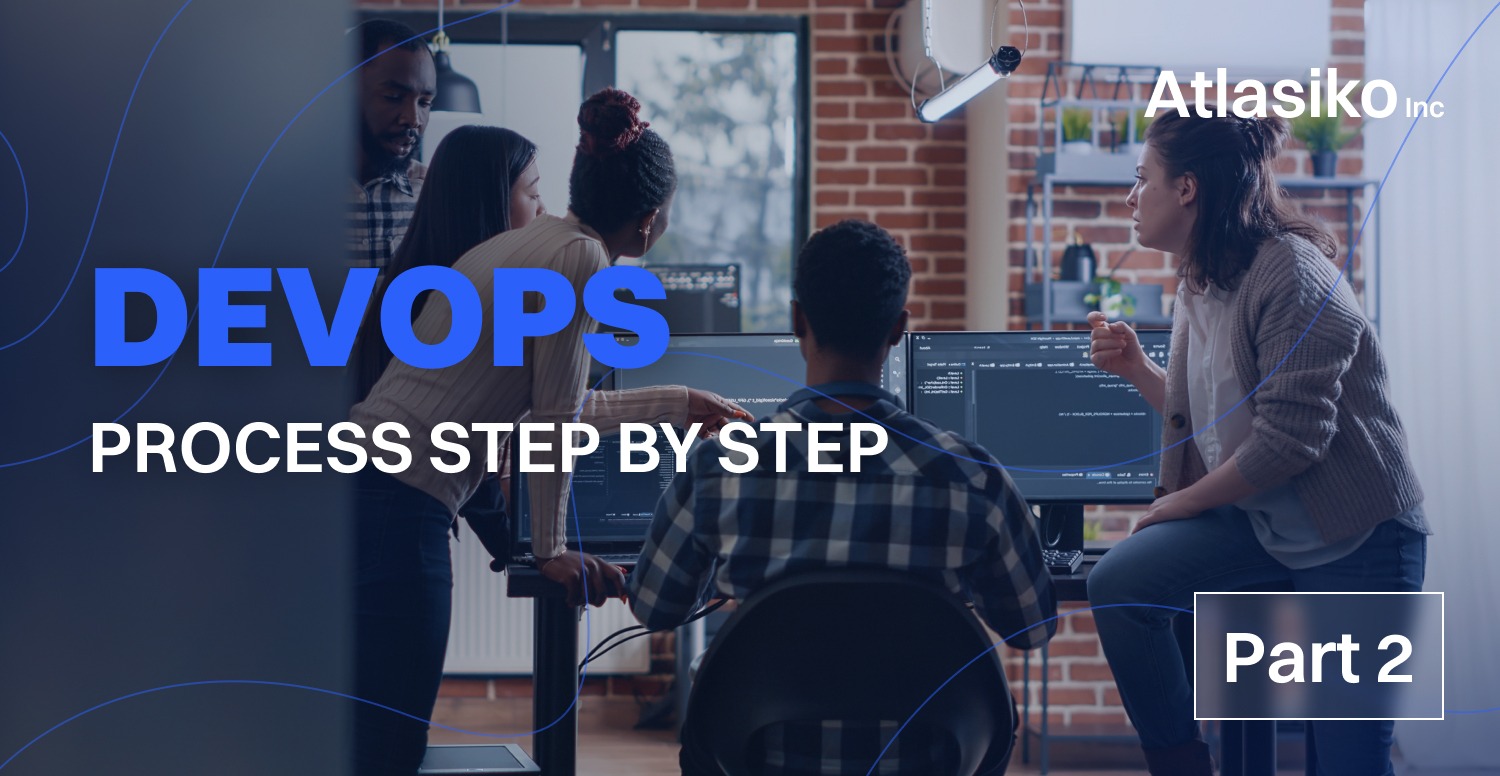


As a software development team lead, I couldn't agree more with the points highlighted in this blog post. DevOps consulting has become an integral part of our development process, and it has made a significant impact on our productivity and overall success. Overall, I highly recommend DevOps consulting to any organization looking to enhance their software development practices. The expertise and guidance provided by a knowledgeable consultant can help streamline workflows, foster collaboration, and ultimately drive business growth. Our experience with a DevOps consultant has been transformative, and I can confidently say that we wouldn't be where we are today without their valuable insights and support. Thank you for sharing this informative blog post. I look forward to reading more on this topic and exploring new ways to optimize our DevOps practices.
Hi! You're absolutely right that DevOps consulting can be a game changer for many businesses. Thank you for your feedback!
Is it realy so different that it worth using in business from what we've been doing for the last few decades? I don't actually see the difference from agile methodology.
Hi, thank you for the comment. DevOps indeed has similar characteristics with the Agile methodology simply because DevOps was developed from it. However, their differences are still significant. We compared these 2 methodologies in the article "DevOps Lifecycle Explained". You can find it in our blog for more info.